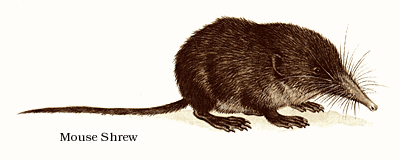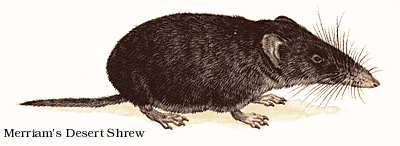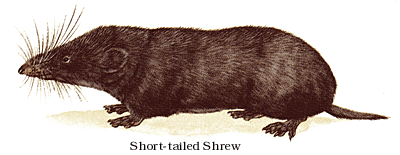Shrews: A Variety of Shrew Species
(just a few of the many species of shrews)
Historical description and attitudes about shrews
Topsell's characterizations highlight the curiously ironical place of shrews in popular folklore. There can be few mammal groups which are less bothersome to humans; yet, few which have been described with such unfavorable dispositions with such words as "shrewd", "shrewish", and "shrew" which were coined originally to describe a rascally or villainous character; although their meanings have changed over the centuries.
Shrews have been accused of being poisoners of horses, scavengers of raven flesh, a cause of lameness in livestock, a certain cure (when burned, powdered and mingled with goose grease) for swelling, and as talismans (magic objects) against shrews and other perceived evils.
The reality of what shrews actually are
- Shrews are small, secretive mammals superficially somewhat mouse-like but with characteristically long, pointed noses.
- They are typically terrestrial, foraging in and under the litter in woods and the vegetation mat under herbage.
- Some shrews are aquatic.
- Ecologically, they are important in breaking down animal tissue and returning raw materials to the soil.
- Their eyes are small, sometimes hidden in their fur; so, their vision seems to be poor.
- Hearing and smell are acute.
- A shrew's foot is not specialized except with the species that regularly go into the water.
- Shrews are very active and consume large amounts of food for their size.
- Studies of several species have shown that their metabolic rate is higher than that of rodents of comparable size.
- The carcasses of some shrews usually are not eaten by other animals because of skin glands that secrete unpalatable odors and tastes.
- Those species whose foraging behavior and dietary habits have been studied have turned out to be opportunists with little specialization.
- They are mainly insectivorous and carnivorous, including carrion; but some also eat seeds, nuts, and other plant material.
- The bite of some shrews is venomous.
- The salivary glands of the American short-tailed shrew, produce enough poison to kill by intravenous injection about 200 mice.
- The poison acts to kill or paralyze before ingestion and may be particularly important in helping to subdue large prey like fish and newts which water shrews are known to consume.
- Several species dig tunnel systems and these may be the focal point of defended territories.
- Tunnel systems may also be important in avoiding predators and usually have more than one entrance and exit.
- Nests of grass and other plant material are usually built in a chamber off the tunnel system and shrews spend most of their sleeping and resting time there.
A summary of some of the main points about shrews
There are more than 200 known species of shrews which are distributed around the world; except Australia and New Zealand, the West Indies, and most of South America.
The majority of modern insectivores belong to the shrew family and they are small to very small; the largest being no larger than a rat, and the smallest, the thick-tailed shrews, are the smallest living mammals. Most of them are said to lead inoffensive lives among the debris of the forest floor or on pasture land, consuming many types of invertebrate (insects and worms with no back bone or spine).
They have five toes and five claws on each foot and their skin glands, and genital or marking glands, secrete a substance with an unpleasant, musky odor. Although shrews are heavily preyed upon by owls and hawks, the acrid-smelling secretions from the shrews' well-developed flank secretions from their flank glands seem to deter most mammalian predators.
Water shrews are known to overpower frogs and small fish, which they kill with venomous bites. The saliva of many shrews contains strong toxins. Carrion may also be included in the shrew's diet.
Shrews rely a great deal on their senses of smell and hearing when hunting because their tiny eyes may not be as useful.
A few examples of shrews, their habitats, and family information

The "Armored Shrews" (Scutisorex somereni) live in forest areas in Uganda, Africa, near Kampala. These shrews are described as having spines which are fortified and strengthened by a mesh of interlocking bony flanges and rods. Armored shrews eat plant material and invertebrates (insects and worms).
Their skeletons show unique developments of dorso-lumbar vertebrae, all very greatly enlarged, widened, deepened, and each with numerous projecting spinous processes interlocking with those of the next vertebra.
The extraordinary development of such vertebrae accounts for the shrews' ability to turn over flat stones, small dead branches, etc. with the thrust of their snouts.
It's possible that the special spinal development is connected with the shrews' methods of finding food which gives tremendous strength for leverage. Its movements are sluggish in contrast to the hurried active movements of other shrews.

"Mouse Shrews" (Myosorex varius) exist in Souith Africa, north to the Limpopo, in moist areas, forest, scrub, and river banks.
Perhaps the most primitive of existing shrews, it has two more teeth in its lower jaw than normal and, therefore, resembles the extinct early mammals, otherwise it is like most shrews.
Mouse shrews do not appear to make or to use borrows; instead, they seek holes and hollows for daytime shelter. Nests of shredded grass are made for sleeping and for use as nurseries. Females produce up to six litters a year of two to four young.

"Masked Shrews" (Sorex cinereus) live in northern North America to New Mexico living primarily in moist forests
It is a common species throughout North America, although less abundant in the arid regions to the south. It inhabits the surface layer of forest, living in and around burrows made by itself and other woodland animals.
It is active day and night, with about seven periods of feeding activity in each 24 hours. Earthworms and snails are their preferred food, but masked shrews eat a wide range of invertebrate prey.
Generally solitary animals, male and female pair only for mating. Several litters of up to ten young are born during the late spring and summer.

"Pygmy White-toothed Shrews" (Suncus etruscus and Sorex minutes) habitat semiarid grassland, scrub, and rocky hillsides in southern Europe, southern Asia, and Africa.
This shrew is regarded as the world's smallest terrestrial mammal because a fully matured pygmy shrew weighs just two grams or about 1/14 oz.
Zoologists don't quite know how such a tiny mammal can survive; but, it must have a constant and reliable source of food, and that is one reason why it is restricted to the warmer parts of the Old World. Its coat is dense which helps to prevent undue heat loss from its tiny body.
Pygmy shrews eat spiders and insects almost as large as they are; including, grasshoppers and cockroaches.
Although no one seems to know anything about their breeding habits, they remain quite abundant, and it may be that their small size "protects" them from being eaten because they share their habitat with larger, more tempting animals as meals for carnivorous hunters.

"Merriam's Desert Shrews" (Megasorex gigas) live in rocky or semi-desert and dry forest areas. They are described as having large, prominent ears and, as is common with most desert mammals, they are active only at night, when they emerge from crevices between boulders or from under rocks to search for insects and worms.
Although they eat up to three-quarters of their own weights ever 24 hours, they apparently feed only at night, unlike other shrews which feed throughout the period. Their breeding habits are not known.

"Short-tailed Shrew" (Blarina brevicauda) live in almost all terrestrial habitats in the eastern United States..
This abundant and widespread species is unusual in two ways: first, it seems to be partly gregarious since, in captivity, it seeks out the company of other shrews; second, it often climbs trees for food which is unusual because most shrews rarely do any climbing.
In much of the U.S.A., the short-tailed shrews are an important controlling ecological influence as they consumes larch sawflies and other destructive forest pests.
These shrews build grassy nests under stumps or logs and produce three or four litters a year of up to nine young each.

"Ceylon Long-tailed Shrew" (Crocidura miya) live in damp and dry forest area and in savannas.
This shrew, with its long, lightly haired tail, spends much of its life within the debris of forest floors, where damp, cool conditions encourage a rich source of insects and worms which they eat. They also consume small lizards and young birds when they can find them. Strong-smelling scent glands apparently protect many of the shrews from such predations by other animals.
The breeding season of the long-tailed shrew lasts from March until November during which a female produces about five litters of about six young. After eight days, the young leave the nest for the first time, each gripping the tail of the one in front in its mouth as the caravan, led by the mother, goes in search of food. This habit seems to be restricted to this genus of shrews.
